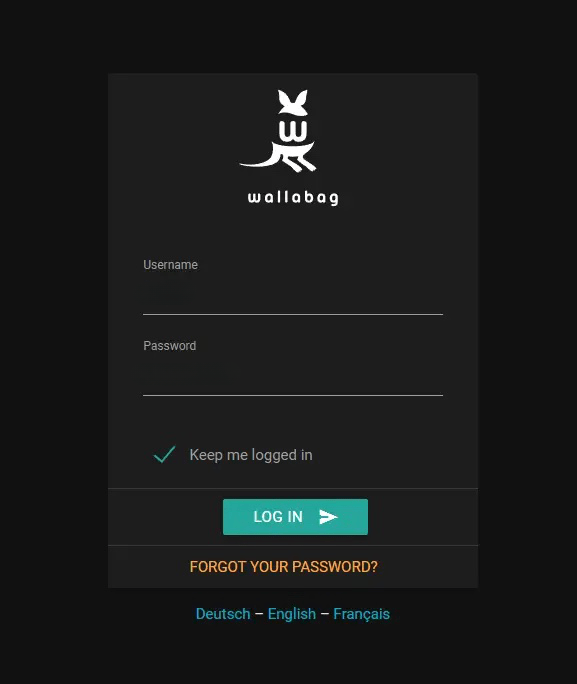How To Install Wallabag on Ubuntu 22.04 LTS

In this tutorial, we will show you how to install Wallabag on Ubuntu 22.04 LTS. For those of you who didn’t know, Wallabag is a self-hosted application that allows users to save web content for later reading. It is an open-source project that aims to provide a simple, privacy-friendly, and ad-free experience for users who want to save articles, videos, and other web content for offline reading. Wallabag is available for Linux, macOS, and Windows operating systems, as well as for mobile devices running Android or iOS.
This article assumes you have at least basic knowledge of Linux, know how to use the shell, and most importantly, you host your site on your own VPS. The installation is quite simple and assumes you are running in the root account, if not you may need to add ‘sudo‘ to the commands to get root privileges. I will show you the step-by-step installation of the Wallabag on Ubuntu 22.04 (Jammy Jellyfish). You can follow the same instructions for Ubuntu 22.04 and any other Debian-based distribution like Linux Mint, Elementary OS, Pop!_OS, and more as well.
Prerequisites
- A server running one of the following operating systems: Ubuntu 22.04, 20.04, and any other Debian-based distribution like Linux Mint.
- It’s recommended that you use a fresh OS install to prevent any potential issues.
- SSH access to the server (or just open Terminal if you’re on a desktop).
- An active internet connection. You’ll need an internet connection to download the necessary packages and dependencies for Wallabag.
- A
non-root sudo useror access to theroot user. We recommend acting as anon-root sudo user, however, as you can harm your system if you’re not careful when acting as the root.
Install Wallabag on Ubuntu 22.04 LTS Jammy Jellyfish
Step 1. First, make sure that all your system packages are up-to-date by running the following apt commands in the terminal.
sudo apt update sudo apt upgrade sudo apt install wget apt-transport-https gnupg2
Step 2. Installing LEMP stack (Nginx, MariDB, and PHP) on Ubuntu 22.04.
Before starting this tutorial, the LEMP server must be installed on your server. If you do not have LEMP Stack installed, you can follow our guide here.
Step 3. Installing Composer.
By default, the Composer is not available on Ubuntu 22.04 base repository. Now run the following command below to download the Composer installer using wget command:
wget -O composer-setup.php https://getcomposer.org/installer
After the Composer has been downloaded, then execute the following command on the command line to install and setup composer on the Linux Ubuntu system:
php composer-setup.php --install-dir=/usr/local/bin --filename=composer
Confirm the installation and check the installed build version of Composer:
composer -V
For additional resources on installing Composer, read the post below:
Step 4. Configuring MariaDB.
By default, MariaDB is not hardened. You can secure MariaDB using the mysql_secure_installation script. you should read and below each step carefully which will set a root password, remove anonymous users, disallow remote root login, and remove the test database and access to secure MariaDB:
mysql_secure_installation
Configure it like this:
- Set root password? [Y/n] y - Remove anonymous users? [Y/n] y - Disallow root login remotely? [Y/n] y - Remove test database and access to it? [Y/n] y - Reload privilege tables now? [Y/n] y
Next, we will need to log in to the MariaDB console and create a database for the Wallabag. Run the following command:
mysql -u root -p
This will prompt you for a password, so enter your MariaDB root password and hit Enter. Once you are logged in to your database server you need to create a database for Wallabag installation:
MariaDB [(none)]> CREATE DATABASE wallabag; MariaDB [(none)]> CREATE USER 'wallabaguser'@'localhost' IDENTIFIED BY 'Your-Strong-Passwd'; MariaDB [(none)]> GRANT ALL PRIVILEGES ON wallabag.* TO 'wallabaguser'@'localhost'; MariaDB [(none)]> FLUSH PRIVILEGES; MariaDB [(none)]> exit;
Step 5. Installing Wallabag on Ubuntu 22.04.
Now we can download and install Wallabag. Run the following command to download the latest version of Wallabag:
sudo mkdir /var/www/html/wallabag -p wget https://wllbg.org/latest-v2-package
Then, extract the downloaded file with the following command:
tar xzf latest-v2-package mv wallabag-2.5.4/* /var/www/html/wallabag
Next, create the asset directory:
mkdir /var/www/html/wallabag/data/assets
Give the Wallabag directory write and execute permissions:
chown -R $USER:$USER /var/www/html/wallabag
After that, switch to the directory:
cd /var/www/html/wallabag
Now create the parameters.yml file by copying the example file:
cp app/config/parameters.yml.dist app/config/parameters.yml
Before start configuring Wallabag, we generate a secret key. Note down the key to be used later:
openssl rand -base64 32 DMV/GpZwDobQbyQZQGDTHvt+ZFJZXwMEIF4KR46=
Next, open the parameters file for editing:
nano app/config/parameters.yml
Add the following configuration:
..........
database_driver: pdo_mysql
database_host: 127.0.0.1
database_port: 3306
database_name: wallabag
database_user: wallabaguser
database_password: Your-Strong-Passwd
Fill in the server description and domain name:
domain_name: https://your-domain.com server_name: "idroot Wallabag"
Fill in the secret key generated before. If you want to keep two-factor authentication, then make sure the following settings are applied:
# A secret key that's used to generate certain security-related tokens
secret: DMV/GpZwDobQbyQZQGDTHvt+ZFJZXwMEIF4KR46=
# two factor stuff
twofactor_auth: true
twofactor_sender: nagdimin@wallabag.it
# fosuser stuff
fosuser_registration: true
fosuser_confirmation: true
.....
from_email: ngadimin@wallabag.it
.....
Save and close the file, then run Composer to download and install the dependencies required by Wallabag:
SYMFONY_ENV=prod composer install --no-dev -o --prefer-dist
Finish the installation using Wallabag command-line tool:
php bin/console wallabag:install --env=prod
You will be prompted if you want to reset the database and its schema. Enter NO as the response both times. Next, you will be asked if you want to create an administrator account. Type yes to proceed and enter the username, password, and email id for the account.
Step 6. Configure Nginx.
Now create a new virtual host configuration file for the Wallabag installation. You can create the file by running the following command:
nano /etc/nginx/conf.d/wallabag.conf
Add the following file:
server {
listen 443 ssl http2;
listen [::]:443 ssl http2;
server_name your-domain.com;
access_log /var/log/nginx/wallabag.access.log;
error_log /var/log/nginx/wallabag.error.log;
# SSL
ssl_certificate /etc/letsencrypt/live/your-domain.com/fullchain.pem;
ssl_certificate_key /etc/letsencrypt/live/your-domain.com/privkey.pem;
ssl_trusted_certificate /etc/letsencrypt/live/your-domain.com/chain.pem;
ssl_session_timeout 5m;
ssl_session_cache shared:MozSSL:10m;
ssl_session_tickets off;
ssl_protocols TLSv1.2 TLSv1.3;
ssl_prefer_server_ciphers on;
ssl_ciphers ECDHE-ECDSA-AES128-GCM-SHA256:ECDHE-RSA-AES128-GCM-SHA256:ECDHE-ECDSA-AES256-GCM-SHA384:ECDHE-RSA-AES256-GCM-SHA384:ECDHE-ECDSA-CHACHA20-POLY1305:ECDHE-RSA-CHACHA20-POLY1305:DHE-RSA-AES128-GCM-SHA256:DHE-RSA-AES256-GCM-SHA384;
ssl_ecdh_curve X25519:prime256v1:secp384r1:secp521r1;
ssl_stapling on;
ssl_stapling_verify on;
ssl_dhparam /etc/ssl/certs/dhparam.pem;
resolver 8.8.8.8;
root /var/www/html/wallabag/web;
location / {
try_files $uri /app.php$is_args$args;
}
# Pass PHP Scripts To FastCGI Server
location ~ ^/app\.php(/|$) {
fastcgi_split_path_info ^(.+\.php)(/.*)$;
fastcgi_pass unix:/run/php/php8.1-fpm.sock; # Depends On The PHP Version
fastcgi_param SCRIPT_FILENAME $realpath_root$fastcgi_script_name;
fastcgi_param DOCUMENT_ROOT $realpath_root;
include fastcgi_params;
internal;
}
location ~ \.php$ {
return 404;
}
}
# enforce HTTPS
server {
listen 80;
listen [::]:80;
server_name your-domain.com;
return 301 https://$host$request_uri;
}
Save and close the file, then Restart the Nginx service to take change effect:
sudo systemctl restart nginx
Step 7. Secure Wallabag with Let’s Encrypt SSL.
First, install the Certbot client using the following command below:
sudo apt install certbot python3-certbot-nginx
Next, get your SSL certificate with Let’s Encrypt by following these steps:
certbot --nginx -d your-domain.com
Let’s Encrypt certificates have 90 days of validity, and it is highly advisable to renew the certificates before they expire. You can test automatic renewal for your certificates by running this command:
sudo certbot renew --dry-run
Step 8. Configure Firewall.
Now we set up an Uncomplicated Firewall (UFW) with Nginx to allow public access on default web ports for HTTP and HTTPS:
sudo ufw allow OpenSSH sudo ufw allow 'Nginx Full' sudo ufw enable
Step 9. Accessing Wallabag Web Interface.
Once successfully installed, now open your web browser and access the Wallabag web interface using the URL https://your-domain.com. You will be redirected to the following page:

Congratulations! You have successfully installed Wallabag. Thanks for using this tutorial for installing Wallabag on Ubuntu 22.04 LTS Jammy Jellyfish system. For additional help or useful information, we recommend you check the Wallabag website.